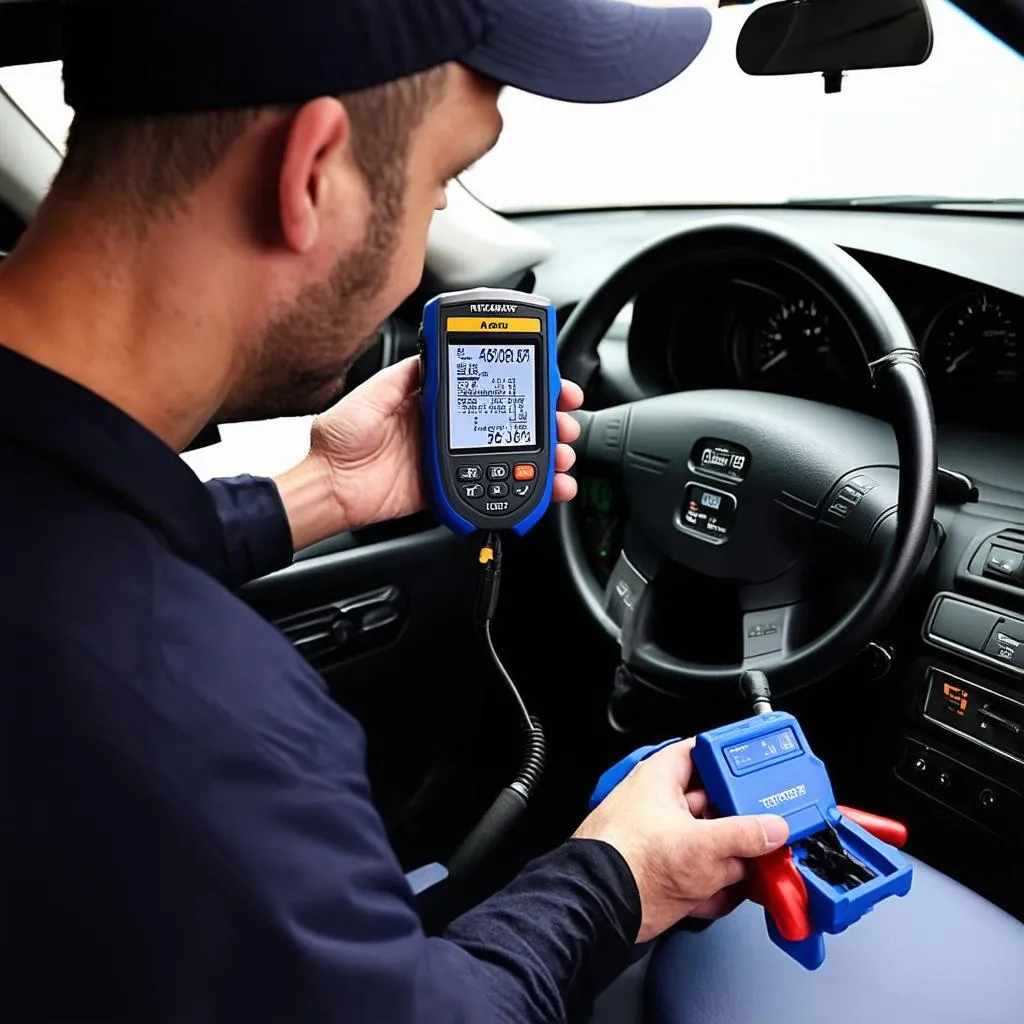Imagine this: you’re cruising down the highway, late for an important meeting, when suddenly your car loses power. You manage to pull over safely, heart pounding, and notice a yellow light glaring at you from the dashboard – the dreaded “Check Engine” light. After quickly connecting your OBD-II scanner, a cryptic code pops up: P1120. Don’t panic! This scenario, while stressful, is more common than you might think.
What Does OBD Code P1120 Really Mean?
In simple terms, OBD code P1120 usually signals a problem with your car’s throttle position sensor or its circuit. This sensor, a critical part of your engine management system, tells your car’s computer how open or closed the throttle plate is. This information dictates how much fuel is injected into the engine. A malfunctioning sensor can send incorrect data, leading to performance issues.
But beyond the technical jargon, what does this mean for you and your car?
Decoding the Symptoms
A P1120 code can manifest in a variety of ways, including:
- Hesitation or Stalling: Just like a hesitant driver, your car might hesitate or even stall when you accelerate, especially from a stop.
- Rough Idle: Instead of a smooth hum, your engine might sound rough and uneven while idling.
- Reduced Fuel Economy: A malfunctioning throttle sensor can disrupt the air-fuel mixture, leading to reduced fuel efficiency.
- Check Engine Light: This is often the first and most obvious sign that something is amiss.
Unraveling the Causes
Several factors can trigger a P1120 code:
- Faulty Throttle Position Sensor: Wear and tear, extreme temperatures, or even a simple short circuit can render the sensor useless.
- Wiring Problems: Damaged or corroded wires in the sensor’s circuit can disrupt the flow of information.
- Mechanical Issues: A sticking throttle plate or a problem with the throttle body itself can also be culprits.
Navigating the Road to Resolution
While the appearance of a P1120 code might seem daunting, understanding the potential causes and symptoms is the first step towards a solution.
Diagnostics and Troubleshooting
Before jumping to conclusions, it’s crucial to properly diagnose the issue. Here’s what you can do:
- Check for Loose Connections: Inspect the wiring harness connected to the throttle position sensor for any loose or damaged wires.
- Test the Sensor: Using a multimeter, you can check the sensor’s resistance and voltage to ensure it’s within the manufacturer’s specifications.
- Inspect the Throttle Body: Look for any signs of dirt, debris, or damage to the throttle body and throttle plate.
Seeking Professional Help
While some DIY enthusiasts might feel comfortable tackling the issue themselves, it’s generally recommended to consult with a qualified mechanic, especially for more complex diagnostics or repairs.
“A misdiagnosed throttle problem can lead to unnecessary part replacements and costly repairs,” warns automotive expert John Miller, author of “The Complete Guide to Automotive Electronics.” “It’s always best to err on the side of caution and seek professional help.”
Beyond P1120: Other Throttle-Related Codes
While P1120 is a common throttle-related code, it’s not the only one. Other codes, such as P1121, P1122, and P1123, indicate similar issues but with different specifics.
Preventative Maintenance is Key
Just like maintaining a healthy lifestyle prevents illnesses, regular car maintenance can prevent many engine problems, including throttle-related issues. Regularly cleaning the throttle body, inspecting the wiring, and ensuring the air filter is clean can go a long way in preventing costly repairs down the road.
OBD Code P1120: Frequently Asked Questions
-
Q: Can I still drive my car with a P1120 code?
- A: While you might be able to drive for a short distance, it’s not recommended. Driving with a faulty throttle position sensor can lead to further damage and potentially dangerous driving conditions.
-
Q: How much does it cost to fix a P1120 code?
- A: The cost of repair can vary widely depending on the underlying issue, the make and model of your car, and labor costs.
-
Q: Can I prevent a P1120 code?
- A: While not all causes are preventable, regular car maintenance, including cleaning the throttle body and inspecting wiring, can significantly reduce the risk.
Find Your Solution at Techcarusa.com
Need help diagnosing or fixing your car’s P1120 code? At Techcarusa.com, we offer a wide range of diagnostic tools and resources to help you get back on the road quickly and safely.
 Car Diagnostic Tool
Car Diagnostic Tool
Related Products
- Dealer-Level OBD Scanners for European Cars
- Throttle Position Sensors
- Throttle Body Cleaning Kits
Supported Car Makes:
- BMW
- Mercedes-Benz
- Audi
- Volkswagen
- Porsche
Explore More:
- Understanding Your Car’s Electrical System
- Common OBD-II Codes and Their Meanings
- DIY Car Maintenance Tips
Need Help? Contact Us!
For expert advice and assistance with your car’s diagnostic needs, contact our team of automotive specialists via WhatsApp at +84767531508. We’re here to help you get back on the road with confidence!
 Car repair
Car repair
Keep Your Car Running Smoothly
Remember, understanding your car’s warning signs and addressing them promptly is crucial for safe and enjoyable driving. Regular maintenance and timely repairs are investments in your car’s longevity and your peace of mind.
We hope this article has provided valuable insights into understanding and addressing OBD code P1120.
Do you have any further questions or experiences to share? Let us know in the comments below!